wide plank flooring - cupping question
We are in the SF Bay Area, where humidity is typically in the 60-85% range.
I've been seriously considering ordering Carlisle Wide Plank Flooring's walnut flooring (4-12" widths), but got concerned when our potential contractor commented that such planks could be subject to cupping. I'm not exactly sure what this is, but it sounds like the edges pulling up.
Has anyone who lives in a similar climate successfully installed and lived with wide plank floors (i.e. not exactly a new installation, which may not yet have shown any cupping)? Or are the wider planks really better suited for a drier location?
Comments (58)
lyfia
16 years agoMaybe engineered wood would be something for you to look into? We have engineered wood floors for that reason in a 5 ply and 1/2" thick and installed on a slab. Very humid climate and even though we have AC it can still be very humid inside. Engineered wood floors is still real wood, just a thinner layer on the top that can be sanded anywhere from 0 times up to 3 times depending on the thickness of the top layer. It is layers of wood glued together which makes it more stable. You could then use the wider boards.
brickeyee
16 years ago"Engineered wood floors is still real wood..."
Just like plywood is still real wood.
Technically true, but it still lacks the look and feel of solid strip (or plank) wood flooring.Related Professionals
Euless Architects & Building Designers · Saint James Architects & Building Designers · Fort Worth Home Builders · Vista Park Home Builders · New Bern General Contractors · Asheboro General Contractors · Enfield General Contractors · Evans General Contractors · Kailua Kona General Contractors · Los Alamitos General Contractors · Murrysville General Contractors · Sauk Village General Contractors · Westminster General Contractors · Wolf Trap General Contractors · Austintown General Contractorsthull
16 years agoSo, I'm curious: is the consensus that no acclimation plus slipsheet/vapor barrier will prevent cupping in wide planks? That's how I'm reading the posts thus far.
But I'd think that, if you acclimated before install and had good moisture control from below (including basement/crawl), you'd be OK.
That and I'd think living in 60-85% RH year round would be clammy and probably make any fabrics parked in closets get mildewy. I'd want some sort of humidity control, probably regardless of the floors.
My parents' house has a large section of wide plank Bruce floor dating to the early 70's. That side is minimally conditioned in the summer, wood heated in the winter, and I've never seen any sign that the floor was anything but stone flat. It's t&g w/ face screws at the ends.
ajpl
16 years agothull, I'm not sure. This time around we also bought kiln dried. We would have loved to have the wood inside the house for a while before installing but where it is a structural element that wasn't possible. We did face nail fromt he start this time so maybe it will be better.
The cupped photo above is strucural as well and over the basement which we live in and where we have our wood stove. I'm not sure how else we would keep it dry although we are installing an HRV system this time.
lbcbuilding
16 years agoWe agonized over this issue for a long time. Finally decided to go with the Armstrong Grand Illusions Laminate. Wide, and as close to a "real wood" look and feel as anything we could find.
demifloyd
16 years agogerberadaisy, I have Carlisle Wide Plank Flooring, walnut, of varying widths, both select and country grades, in my home.
It is the second installation of walnut because the first installer did not follow instructions like he was supposed to and in fact, ruined the most beautiful planks you've ever seen.
But the second installer that installed the new wood apparently knew what he was doing. I live in Louisiana, where it is quite humid. We have had no problems after two and a half years.
housewitch
16 years agoI live in the humid southeast. We installed 8" wide southern yellow pine floors throughout the house 4.5 years ago. They are t&g, with no pegging or face nailing. We've never had any problems at all with cupping.
mnk716
16 years agoI had 5" walnut prefinished floors installed in Long Island, NY (cold winters, very humid summers). they were in the house for 5 days before installation then installed with the 15# felt and perpendicular to the floor joists. after 12 months we never had a problem with cupping, the softness of the wood is another issue.
i agee with housewitch installation is the key.
i SOOOO miss those floors. i kept pictures of it. My new house has regular 2" oak flooring. nothing like the beauty of dark walnut.
brickeyee
16 years agoThe grain of the wood has far more to do with cupping than how it is installed.
You simply cannot prevent wood from moving when the humidity changes.
If you nail a wide board and restrict the movement, it simply expands and crushed the wood at the fasteners, than shrinks and split.
Wood moves with moisture content. Period.
The only thing you can do is slow the movement with surface finishes, but it will never be zero.
No finish completely blocks water vapor movement.lyfia
16 years agobrickeyee - true on the engineered being like plywood, but my comment was it is real wood vs. lets say a laminate that is just made to look like wood. Ie all the material except the glue is still wood.
karenyang
Original Author16 years agothank you all for your comments, this has been really helpful (and a little bit scary....I remain undecided about using the planks in CA!).
Demifloyd, I can't imagine that where I live is more humid than Louisiana, so your post gives me hope. Would you mind posting or emailing pics of your select grade walnut? This is the direction I was heading (before the "great cupping scare of 2008"....).
Thanks everyone!!
demifloyd
16 years agogerberadaisy,
We of course acclimated our wood according to Carlisle's instructions. This is most important, as is following their instructions--they are quite helpful in answering questions. I would suggest you might call them with your concerns.
In photo number three--of the stair landing--you can see a country grade board in the foreground. The ones in the closeup photo (second photo) appear to be all select grade.
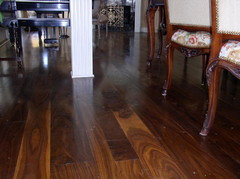

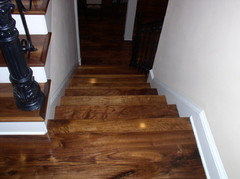
karenyang
Original Author16 years agodemifloyd - beautiful! It's nice to see that a GW'ber's install looks as nice as the pics on Carlisle's website.
They've been incredibly helpful thus far, even offering to communicate directly with our contractor (we may take them up on this).
Is your floor finished with tung oil or polyurethane? The depth of the grain is lovely.
demifloyd
16 years agoThank you, gerberadaisy--these floors are our favorite part of the house. Not a day goes by that I don't enjoy looking at them.
We used the tung oil finish.
lsst
16 years agoDemifloyd,
That is some of the most beautiful flooring I have ever seen.
It makes me want to rip out my flooring and start over!landp
16 years agoDemifloyd,
Ditto the others' comments on your floors--so beautiful! We're a few months from ordering our reclaimed 5" planks, and I've been worried a bit. We're just above Alexandria, LA.
They'll be cut to t&g, and will be left "dirty top," which basically is left pretty much alone, so the old indentions and nail holes are intact. Does anyone have experience with this? Should it make any difference in tendency to cup?
Thanks.
emilynewhome
16 years agoDemifloyd, beautiful floor! Did you install directly over slab? What did you have to do to prepare the slab for solid wood? Thanks!
demifloyd
16 years agolsst, landp anad emilynewhome--thank you so much!
Believe me you don't want to rip out flooring. As I may have mentioned, the first walnut was even prettier and it all was ripped out three days after we moved into the house. I lived on concrete for four months waiting for a new shipment, acclimation of the wood and installation. It is not any fun!
No, we did not install the wood directly over the slab. These are solid walnut floors; some people have been installing solid wood (as opposed to engineered wood) directly over slabs for some time and it has become more common the last few years. In the past that has generally not been recommended by most wood experts, although the man that installed mine has actually done it. I preferred not to take any chances, especially in light of the first debacle and we installed ours over plywood, nailed and glued per Carlisle's instructions.
I do know some people who did install solid wood directly over a slab and they have had problems; my builder did it (the same guy that did my last installation installed his, as well, but it wasn't Carlisle wood) and to my knowledge his is holding up after almost three years. I do believe the success of such a venture is dependent on many factors, including the location/humidity, type of wood, acclimation, the slab preparation, and of course the installation.
landp, my installer explained that in some types of reclaimed wood, the wood has dried out and is less likely to cup or change. Of course he was referring to the reclaimed wood he was selling, much of it from the northeast section of the country. I think it's a case by case basis. In any event, I would love to see photos of your antique/reclaimed floors!
dogtrnr
16 years agoSo glad I found you all.
We are getting delivery of our Eastern White Pine Hit or Miss flooring in 2 days.
I asked Rick Menard at Carlisle to refer an installer, as I didn't want to chance ruining the flooring.
You may want to do that as well if you are getting flooring from them.
We are using 10 - 15' wide plank, gingerbread stain with tung oil finish.
Ours is a very 'organic' type of home in CT... granite floor to ceiling double sided fireplace in the family room/dining room, a wood burning stove, very very high ceilings.
I just can't wait to see it finished.
Another reason I went with Carlisle is that we originally contacted them to do our home on LI 7 years ago, and never got the work done. When we moved and I contacted Rick again he remembered me and has been nothing but helpful and professional.
demifloyd, your floors are stunning :)
demifloyd
16 years agodogtrnr, thank you so much! Please post photos of your Carlisle Eastern White Pine and please give Rick my regards--just tell him I'm the lady with the re-do of walnut in Louisiana, he knows who I am! He is just top notch, isn't he?
fancycar
16 years agoHi demifloyd, You can say hi yourself, and your home came out beautifully. Not surprising, knowing all of the work you did to it. Dogtrnr, I am excited to hear how you will like your floors.
Brickeyee, you are correct when you say grain has a lot to do with your planks moving. The more vertical grain you have, the less the planks will move. Also, the tighter the grain, the less your planks will move. Try to pick material from Old Growth timbers, then center cut from those trees. The way your planks are dried will also have a great affect. Air drying for an extended period of time before kiln drying is a tremendous help. The better the quality of wood you start with, the less problems you will have.
The way you install floors is another big piece of the pie for trouble free floors. Depending on your sub-floor, you can nail and glue, (use a glue that stills allows the wood to expand and contract), directly to the sub-floor. If memory serves me right, demidloyd's floor was installed on a plywood sub-floor over sleepers on a concrete slab. And you see how beautiful that turned out.
The tung-oil finish is a fantastic choice, but be careful what type you use. They are not all the same. If you are going to use a pre-finished floor, work with a company that will also put a coat on the back of the planks, (back sealed), as this will also greatly minimize wood movement.
I hope this is helpful to everyone.
Rick
landp
16 years agoDemifloyd,
Wish I did have pictures! We're now getting 7" instead of 5". Our supplier says they haven't had any trouble with up to 7" w/o any additional prep to the underside of the boards. In wider ones, they do something (scrape it, maybe?) in some purposeful manner that helps keep the cupping under control.kats
16 years agoWe live in California and looked at both Carlisle and engineered. Cupping wasn't something we wanted to deal with so we chose engineered. It's 8" wide plank, natural white oak. It is not stained and we use tung oil to clean it. Scratches almost disappear and I think any that remain add to the character of the wood. I cannot be happier with the look of my floors. If I remember right it's 3/4" of solid oak with 5 more layers of pressed woods going in cross sections.
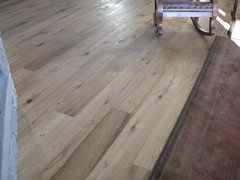
emilynewhome
16 years agoKats, what brand is your new floor it looks really nice, also what is the stain? Thanks!
dckcssw
16 years agoHi Everyone,
I just would like to share some thoughts on these issues of wood moving, the widths of the flooring and the environment you live in. I have grown up with wide plank floors as this was my parents passion and continue to carry on the tradition know with my own home. To the person who is deciding whether or not to use wide plank walnut in her home in California, I hope this is helpful. The climate in New Hampshire where I live is much more difficult on a basis of change in moisture to wood floors than where you live. I have seven to 12" hickory, white oak and pine on my floors and my parents have cherry, white oak, pine and they are flat and beautiful and will remain this way for the life of the home. If you aesthetically enjoy Walnut, which is beautiful and will be the entire backdrop for the look of the room or home, then you should use this wood. It is beautiful and very stable and has been used in for hundreds of years as one of the most ornate and majestic of all woods. When thinking of how it will perform as far as staying flat (cupping or crowing) you want to remember some simple principles of wood. Wood moves in direction with its grain, more vertical grain ensures the floors will stay flat, this is what was done in your older floors dating back hundreds of years and is time tested. Secondly, cupping or crowning only occurs if you have a drastic problem and the floors are not installed properly, quite honestly if you have problems, you'll have them with anything and this should not be related to the wood choice. Good quality wood is much more resistant and tolerable to moisture an change than people give it credit for. If you have created a reasonably good environment for flooring then you'll have great results. You really are not in a tremendously humid area like in the some areas of the country but if you want you can even leave expansion gaps(about the size of a quarter) every 3 or 4 feet and this will allow the floors some room to expand. Actually, contrary to some of what I've read, the wider flooring will have much better results than the narrow flooring. It comes from an old mature tree and is of much higher quality than they make narrow floors from. Hence being the reason they need to be cut into small strips and as of late have resorted to glueing this low quality wood to plywood to make "engineered" flooring to expand the market area they can sell into. This is probably the best option for the wood, however, don't mistake it with wood in general as good quality wood will stay flat as a pancake and has done so for a long time.karenyang
Original Author16 years agodckcssw - I was the OP and appreciate your (and everyone else's) comments!
I agree - I didn't think that Northern CA was particularly humid compared to other parts of the country, so I was surprised to see the high humidity rates I found (statistics plucked from weather.com).
I'm finding that, as with most things, the more I learn about wood and flooring, the more I realize I don't know. I've never seen anyone around here with a cupping problem, but most people seem to have 3" wide wood strips versus wide plank flooring, hence my original question - we just don't see a lot of wide plank flooring around here, not sure why.
I will need to go research "vertical grain" to figure out what that is, and whether or not this is what Carlisle carries! Thanks for bringing this to my attention.
I recently discovered that the look of flooring I like involves not only wide planks, but eased edges, so now I'm on an eased edge walnut hunt (which Carlisle seems not to carry).
Thanks for all the comments and photos, everyone - very helpful!!
alliern
16 years agoAfter a lot of research, we have decided to use Owens PlankFloor in our home. It is an engineered floor that comes in widths up to 6". The samples that I have are beautiful. We are going to use the walnut. You can get them unfinished with a square edge or you can get them prefinished with an eased edge. The cost is about half of Carlisle and they are comparable in beauty.
kath2008
16 years agoWhat would be Carlisile's instructions for laying the wood over the Concrete Slab with radiant heat. I am interested in the same floors as demifloyd as they are beautiful. But what would be the widest widths you would be able to use as I do not have enough height to put plywood down over the concrete slab.
monicabburke
8 years agoThis is not the same company I used 20 years ago for my hardwood floors. Carlisle recommended the contractor, Steve Martin of Fusion Flooring, who had no experience with this particular flooring and had no knowledge of how to install the wide planks. The product was defective with multiple cracking, and combined with a contractor who failed to acclimate the wood properly. (See pictures below) Customer service was non existent. So, I contacted Chris Sy, one of the principles, of Carlise, and he offered no help or assistance to right the wrong. We are in litigation. I live in Corona del Mar, California...Hope this helps.
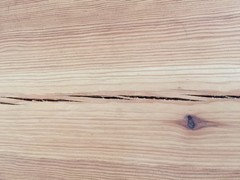
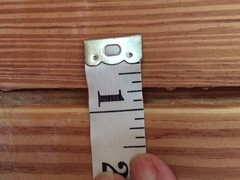
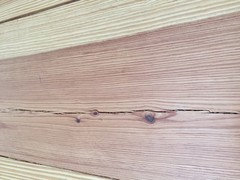
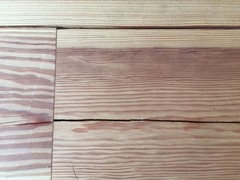
bry911
8 years agolast modified: 8 years agoIf, after 7 years, it has not been resolved, I don't think the information you gave is really going to help...
millworkman
8 years agolast modified: 8 years agoThis is the confusing part of Houzz to me. This is obviously spam, but by having a pro account this is allowed? This is a 7 year old post with people asking about flooring issues not a place to pop up a billboard in my opinion.....
Carlisle Wide Plank Floors
8 years agoThanks for your feedback "millworkman". We recognize this is an old post, but also that people continue to use these posts long after the initial discussion began. When we come across these discussion, we try to respond to the initial question, so when people read the post in the future, they have accurate information.
millworkman
8 years agoJust seems to me to be a little bit more like Spam, but apparently Houzz doesn't mind it so........
robsama
8 years agoI, for one, just found this link as I am looking into replacing my existing 7" pine floors with something a bit harder but in keeping with the same 7' width. So I am glad this thread was resurrected. However, millworkman, I'm not sure why you are getting so worked up. Monicaburke doesn't appear to have a Pro account or be advocating FOR the product but rather AGAINST it. She is unhappy with her floors so where exactly do you see this billboard you speak of? I think maybe you and live_wire_oak need to go back and review the recent posts.
Thank you to those that posted your experiences. I still have no idea what I'm going to do because there are so many choices. My contractor wants to face nail anything over 5" and I'm trying to find a product that I can use that will convince him not to.poppasmurf302
7 years agoI didnt see anyone post about strip gluing wide planks - we install alot of wide plank solid wood and engineered floors. one answer that is backed by every flooring manufacturer we checked, is running strips of polyurethane glue or bostiks best in between the floor joist. I wouldnt trust anything less....but a 4 inch v-notch trowel does the trick. it holds the middle of the planks down, prevents cupping, and takes out some of the give in between the joists. it is specified as mandatory from some solid wood flooring manufacturers for anything wider than 5 inch. it also works for subfloors that are 1/2" thick instead of 3/4". just rack it out with a 1-2 foot gap, spread the glue between the joist nails(perpindicular to the flooring) and lift it over as you go. this is specified by the flooring manufacturers, so not just my opinion or new idea - it works
Carlisle Wide Plank Floors
7 years agoUsing a poly based glue, such as PL-Premium is recommended for wide plank boards, when installed on plywood and radiant heat. This is generally a super easy process and very little additional cost. You can also install some wide plank floors direct to concrete, although the glue would be more of a full spread mastic, brands include Bostiks Best, Sika, or as recommended by your installer.
User
5 years agoLook, I am posting 10 years after OP, so these threads are worthwhile. I was just curious because I want about 2000 sf of wood in my Michigan home, one dealer is trying to sell me 3/4 inch solid hardwood in whatever size width I like, and the next dealer is saying he would never recommend a solid hardwood wider than 3 inches because of the cupping and shrinking factor due to our climate. Hmmmm. Which one is trying to pull one over on me? The search continues....
poppasmurf302
5 years agobefore installing, we always take moisture readings of the subfloor, to make sure there is not a moisture problem. being that its your house, i would suggest buying a wood moisture guage - if you want to be sure ), test different areas(near exterior walls, windows, doors) to make sure the subfloor is around 7%... above 10% is risky. if the humidity and temperate inside the home is consistent, and no moisture problem exists, you should be safe with any size(strip glue 5" and up either way). if you have the time to test moisture during summer and winter, you can be certain the conditions are good. it is usually basements with water problems that cause super high humidity, and soaks into the subfloor (from underneath), and eventually into the floor, or plumbing leaks are the 2 causes that i usually see - good luck
Holly Stockley
5 years agoIt depends on the flooring, to a degree, as well as the subfloor as was just mentioned. But, being a fellow Michigander, I understand the extremes of humidity we get. For most flooring, wider than 4" on a solid plank is probably a bad idea. If you go with a reclaimed wood that has a very tight grain and is already super dry (reclaimed wood is usually old growth, so the grain is tighter to start with. You can increase your chances by going for a species that tends to BE tight to start with.) you might could push that to 7". If you want anything wider than that, you probably should look into engineered.
Holly Stockley
5 years agoHi, Red!
If we follow your link out to their blog, they even have a post on "how wide":
http://alleghenymountainhardwoodflooring.com/wideplankflooring/ILoveRed
5 years agoI think I accidentally deleted the comment Holly when I was trying to edit it.
Yes that is the link. Lots of really good information on that website. My hard wood came from this company. It has been acclimating in my House for several weeks now.
I am using 7” Live Sawn white oak which is a combo of plain, quarter and rift. I have tight control of humidity in my house and we rarely open our windows. Hope I’m not deluding myself, lol.
this wood expands up rather than sideways. I really wanted a rustic, casual feel with wide, long boards and this is my choice. Hope I don’t regret it.
Beth Coleman
3 years agoHow did your floors turn out? I live in central Illinois and would like 7” solid white oak for a new build but I am also worried about the cupping issues. This would be a house with a basement Have you had any issues with cupping or movement?
ILoveRed
3 years agoBeth...I love my floors. They are beautiful. we have a finished basement under our house. We have whole House humidifiers on our HVAC and erv/hrv. We live on a lake but we rarely ever open our windows. Even though this cut of wood is more stable than plain sawn oak we still are very cautious with our humidity level within our home. We have a cheap hygrometer, check our humidity every few days and keep it at about 45%. That means turn on the humidifier when necessary in the winter, keep the windows shut in the hot humid summer and turn off the hrv when it’s very humid in the summer. It sounds complicated but it’s really not.
no problems with cupping but we are careful. I think there might be if you weren’t.
let me know if you want the name of our flooring guy in Arthur. First time he has done Live Sawn Oak...he did a fabulous job. This is the only pic I can find right now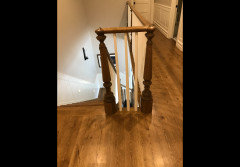
ILoveRed
3 years agoOh and his relative built my stairways. The two of them worked together to make sure my stairs were the same wood with the same stain so everything matched. Craftsman stair guy too if you want his name. Not cheap but worth every penny.
Beth Coleman
3 years agoThank you so much for the response! I am really happy to hear this! We are looking at rift and quarter sawn white oak in 7” planks. We will also have a humid on the furnace. We run a portable dehumidifier in the basement and use hygrometers as well (had problems with cupping in previous house with crawlspace. We had an hrv in that house too but aren’t planning to do that in this home unless needed. If needed or we get nervous, we can put a dehumidifier on the furnace for humid times of year. The humidity worries me a little as it takes a year or so for new homes to dry out (lumber etc...). Even in summer with dehumidifiers and a/c on, we would stay at aroun 50% or 55% humidity a lot. Not sure how accurate the cheap hygrometers are. I know too dry doesn’t physically feel great for me! I prefer 50-55%. That said, maybe I should stick with 5” boards. Never had trouble with these cupping. If we decide to go with the 7” planks, they will be nailed and glued. Our builder uses an installer from. Chicago so I don’t think we will be able to change this. Thanks for the offer! Our cabinet guy is from Arthur! He’s great!
ILoveRed
3 years agoMust be camera distortion Mark, lol.
beth, sounds like you are educated and know what you need to do. The 5” boards should be very nice too..especially in rift and quarter sawn oak. My dd is building and has a bunch of littles running around so I advised her to go with a narrower board since they will be running in and out all of the time and she likes to open her windows. Our boards are nailed and glued as well. Our cabinetmaker is also from Arthur. Wonder if you are using the same company. Lots of amazing craftsmen in that area. anyway..good luck! Challenging time to build but it will be worth it.







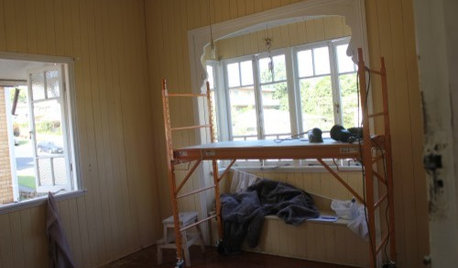

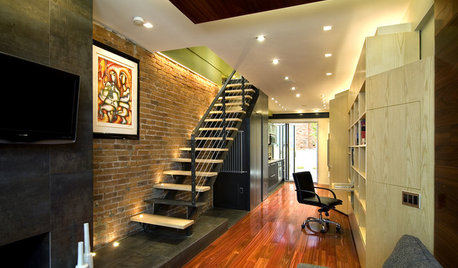







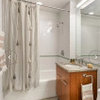

live_wire_oak